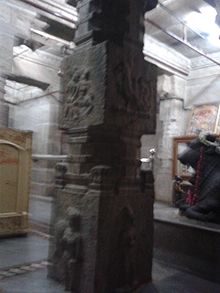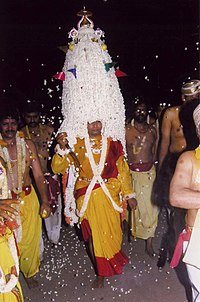This is an old revision of this page, as edited by Eshwar.om (talk | contribs) at 12:35, 13 June 2013 (restored). The present address (URL) is a permanent link to this revision, which may differ significantly from the current revision.
Revision as of 12:35, 13 June 2013 by Eshwar.om (talk | contribs) (restored)(diff) ← Previous revision | Latest revision (diff) | Newer revision → (diff)| This article has no lead section. Please improve this article by adding one in your own words. (June 2013) (Learn how and when to remove this message) |

History


The Chokkanathaswamy temple Tamil Inscription
Illaipakka Nadu (present day Yelahanka)
Yelahanka is referred to as Illaipakka Nadu of Rajendra Solavala Nadu (Gangaikondachola) in the inscriptions.
Tombalur or Desimanikkapattanam(present day Domlur)
Domlur itself is referred to as Tombalur and as Desimanikkapattanam in the inscriptions.
The Chokkanathaswamy temple which is the oldest in the City. The temple stands on a high base and probably was in the centre of the locality and once a prominent structure.The Tamil inscriptions of Chakravarthi Posalaviraramanatha Deva are addressed to the authorities of all temples in his kingdom. One epigraphy says that all kinds of taxes, tributes and tolls of Sondekoppa village have been granted by Devaraya II of Vijayanagar to the temple. The wet and dry lands in Tombalur together with wells, trees, houses are granted to God Sokkapperumal. On the door frame dated about 1270 AD, it is written in Tamil that one Alagiyar donated the two door posts. Another Tamil inscription says, one Talaikkattu (maybe a general) and his wife donated as tax-free the temple property, for the God Tripurantaka Perumal, as also the dry and wet lands in the village of Jalapalli, the tank at Vinnamangalam and other lands below the big tank of Tombalur. The charge of the temple was given to Talai Sankurappachariyan.
The Chokkanathaswamy temple
The Chokkanathaswamy temple inscriptions on the temple suggest it belongs to the Chola period.Tucked in a bylane, not very far from the main Domlur Road is a quaint west-facing 10th century Chola temple, called the Chokkanathaswamy temple which is the oldest in the City. The temple stands on a high base and probably was in the centre of the locality and once a prominent structure.
Saligrama stone
The images of Vishnu or Sokka Perumal, his consorts Sri and Bhu in the garbhagriha, are carved from the saligrama stone from Gantikinadi (Nepal), the only place where the sacred stone is found. It was found that one of his consorts Bhudevi had a small chip off her nose. To correct this, the entire figure was scraped and the same was done to the other consort Sridevi too.
Tiruppavai
Old Madivala Someswhara temple Tamil inscriptions
| This section is empty. You can help by adding to it. (June 2013) |
‘Veppur’ (modern-day Begur)
The earliest record dates to 1247 AD and refers to lands donated “below the big tank of Vengalur” by a resident of ‘Veppur’ (modern-day Begur).
Tamaraikkirai (present day Tavarekere)
Tamaraikkirai (meaning ‘the banks of the lotus pond’ in Tamil). Epigraphy expert H S Gopala Rao, Secretary of the Karnataka Itihasa Academy, points out that this is the old name for what we today know as Tavarekere.
Old Madivala Someswhara temple

The stone temple is said to be a Chola period temple, making it one among Bangalore’s oldest. And there is ample proof of its antiquity. Large portions of its outer walls are covered with inscriptions in Tamil and Grantha (an old script used to write Sanskrit) characters, attesting to the temple’s age. The earliest record dates to 1247 AD.The temple underwent extensive renovations five years ago,the inscriptions were largely unharmed. The temple’s outer walls that carry the inscriptions and also idols of various gods including Ganesha, Durga and Vishnu, remain unaltered.Inside, apart from shiny new flooring, the garba griha and artha mantapa were untouched. These inner chambers still remain small and darkened spaces that encourage a personal and intimate communion with the Lord. Apart from four carved pillars, the artha mantapa has a large and elegantly proportioned granite Nandi facing the linga. Behind the Nandi, the eastern wall of the temple has a small opening that is directly in line with the linga.
Twin cities
In the 19th century, Bangalore essentially became a twin city, with the "pētē", whose residents were predominantly Kannadigas, and the "cantonment" created by the British, whose residents were predominantly Tamils.
Places renamed into Kannada Language (1960's)
Tamil was more visible in the city through newspapers, movies and trade unions. Therefore the Kannada movement was a concerted effort to give more visibility and audibility to their language and to stake their claim over the city by renaming streets, making it mandatory for businesses to display signage in Kannada.
Protest against MS Subbalakshmi's concert(1962)
In 1962, leading litterateur Aa Na Krishna Rao launched a protest against (the Tamilian) MS Subbalakshmi's concert during the Ramanavami festival in Bangalore, decrying the neglect of Kannada artistes saying "Idu Ramotsava alla, Tamilotsava" ("This is not a festival for Rama, but of Tamils") .
At Present days
Today, the erstwhile Cantonment area of Bangalore comprising Ulsoor, Shivajinagar, Benson Town, Richard’s Town, Frazer Town, Austin Town, Richmond Town, Cox Town, Murphy Town and others still boast a large Tamil populace , .Tamil-speaking people are largely found in the districts of Bengaluru Urban, Bangalore Rural.According to Indian Express news,Out of 1.67 lakh voters in Shivajinagar, 92,000 are Tamil speaking people. .
Largest ethnolinguistic minority in Bangalore city
In 1991, Tamils constituted the largest ethnolinguistic minority in Bangalore city making up 21.38% of the total population. Today, Tamil speakers form an estimated 25-30 percent of the population of Bangalore city. As of 1971, Tamil formed the second-largest mother tongue in Bengaluru .
Hebbar Iyengar

Hebbar Iyengars were formerly an endogamous group and constitute a part of the Iyengar sub-caste of the Karnataka Brahmins. They are traditionally followers of Ramanuja and Vedanta Desika. They hail primarily from Hassan, Mysore, Tumkur, Bangalore, and surrounding areas in southern Karnataka. The characteristic dialect of the Hebbar Iyengars is called Hebbar Tamil and is a mixture of Iyengar Tamil, Kannada and Sanskrit. The group's primary mother tongue is Hebbar Tamil which is spoken in most Hebbar Iyengar households, though Kannada and English are increasingly taking its place. A peculiar characteristic of Iyengar Tamil (including Hebbar Tamil) is its retention of divine or holy food terminology. For example, Iyengar Tamil makes distinctions between potable () and non-potable water (), the former considered sacred but both borrowed from Sanskrit. Standard Tamil exhibits only the generic term for 'water'.
The Vaishnavite Brahmins

The Vaishnavite Brahmins of Southern Karnataka use the Tamil surname "Iyengar" and are believed to have migrated during the time of the 11th century Vaishnavite saint Ramanujacharya. Most Iyengars in Karnataka use sub-dialects of Iyengar Tamil.
Southern Karnataka
Tamil-speaking people are largely found in the districts of Bengaluru Urban, Bangalore Rural, Mysore, Mandya, Kolar, Ramanagara and Chamarajanagar in southern Karnataka.In Karnataka, Tamils form 3.46% of the total population of the state. Almost 5 million Tamils live outside Tamil Nadu, inside India. There has been a recorded presence of Tamil-speaking people in Southern Karnataka since the 10th century.
Thigala or Tigala
The Thigala or Tigala are a Tamil social group found in Tamil Nadu and Karnataka states of India, and particularly the city of Bangalore. They are likely a sub-caste of the numerous Vanniar caste. Every year, the Thigalas celebrate a festival called Karaga. The story of the Karaga is also rooted in the Mahabharata.Draupadi is the community deity of the Vanhikula KshytriyasThe Thigala in Karnataka speak a mixture of Kannada and Tamil. At this time, Draupadi, the Pandava's wife, took the form of Shakthi devi. She created a huge army of soldiers called the Veerakumaras. After defeating the Asura, the soldiers asked Shakthi Devi to stay back with them. Though she had to go back, she promised them that she would come to stay with them every year during the first full moon of the first month of the Hindu calendar.Thigalas believe that their origins date to the time of the Mahabharatha epic.
Bengaluru Karaga

Bengaluru Karaga is one of the oldest festivals celebrated in the heart of Bengaluru. Bengaluru Karaga is primarily a well-known tradition of Thigala community in southern Karnataka. The Karaga festival is generally led by the men of the community. There is a legend which gives them this privilege. Thigalas believe that in the last part of the Mahabharatha, when the Pandavas were shown a glimpse of hell, one last Asura (Demon) called Tripurasura was still alive.
Mahabharatha and Bengaluru Karaga

At this time, Draupadi, the Pandava's wife, took the form of Shakthi devi. She created a huge army of soldiers called the Veerakumaras. After defeating the Asura, the soldiers asked Shakthi Devi to stay back with them. Though she had to go back, she promised them that she would come to stay with them every year during the first full moon of the first month of the Hindu calendar
Kempe Gowda
He built the Bangalore fort and the town in 1537 A D. And moved his capital from Yelahanka to the new Bangalore. Some believe that Kempe Gowda, the founder of Bangalore city, was a Vanniyakula Kshatriya from Kanchipuram district.Yelahanka is referred Illaipakka Nadu in the Tamil Incription,10th century Chola temple,Domlur,Banglore.
References
- ^ "History Of the Temple".
- ^ "DeccanHerald". DeccanHerald.
- "DeccanHerald".
- "IBN LIVE".
- KANNADA MOVEMENT (PDF). p. 50.
- Banaglore history (PDF).
- bangalorenotes (PDF). p. 4.
- Tamil area (PDF). p. 5.
- "discoverbangalore".
- "Indian Express". Indian Express.
- "REUTERS". REUTERS. Mon Feb 5, 2007.
{{cite news}}: Check date values in:|date=(help) - P. Padmanabha. Census of India, 1971. Manager of Publications. pp. 668–669.
- "censusindia".
- Smriti Srinivas (2004). "The Settlement of Tamil speaking Groups". Landscapes of Urban Memory. Orient Blackswan. pp. 100–102. ISBN 9788125022541.
- ^ People of India. p. 1423.
- "Bangaluru karaga". THE HINDU.
- ^ "bangaloremirror". bangaloremirror.
- Landscapes of Urban Memeory: The Sacred and the Civic in India's High-tech City.
- "History of the temple Incription".